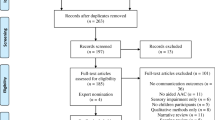Abstract
We surveyed New Zealand residential facilities/assisted-living programs for adults with intellectual disabilities (ID) to document the need for, and provision of, augmentative and alternative communication (AAC). Organizations (n = 100) registered to provide residential care/assisted-living to adults with ID across New Zealand were invited to complete a paper or online survey. Fifty seven organizations representing 127 separate facilities/assisted living programs responded. The facilities/programs accommodated 2,356 adults and employed 3,062 staff. Nearly one-third (28.8 %) of the adults were identified as candidates for AAC intervention. However, most staff had limited or no AAC experience and perceived considerable need for training in this area. We conclude there is substantial need for AAC intervention among adults with ID in New Zealand residential facilities/assisted-living programs. To facilitate this, support staff may need training to ensure effective interaction with AAC users and competence in providing effective AAC intervention.
Similar content being viewed by others
References
Abbeduto, L., Evans, J., & Dolan, T. (2001). Theoretical perspectives on language and communication problems in mental retardation and developmental disabilities. Mental Retardation and Developmental Disabilities Research Reviews, 7, 45–55.
Beukelman, D. R., & Mirenda, P. (2013). Augmentative and alternative communication: Supporting children and adults with complex communication needs (4th ed.). Baltimore: Paul H. Brookes Publishing Co.
McCalland, F., & Moodie, E. (1998). Training staff to support AAC users in Scotland: current status and needs. Augmentative and Alternative Communication, 14, 228–238.
Reichle, J., York, J., & Sigafoos, J. (1991). Implementing augmentative and alternative communication: Strategies for learners with severe disabilities. Baltimore: Paul H. Brookes Publishing Co.
Schepis, M., & Reid, D. (2003). Issues affecting staff enhancement of speech-generating device use among people with severe cognitive disabilities. Augmentative and Alternative Communication, 19, 59–65.
Schlosser, R. W. (Ed.). (2003). The efficacy of augmentative and alternative communication: Toward evidence-based practice. Boston: Academic.
Sigafoos, J. (2010). Introduction to the special issue on augmentative and alternative communication. Journal of Developmental and Physical Disabilities, 22, 101–104.
Sigafoos, J., & Iacono, T. (1993). Selecting augmentative and alternative communication devices for persons with severe disabilities: some factors for educational teams to consider. Australia and New Zealand Journal of Developmental Disabilities, 18, 133–146.
Sigafoos, J., O’Reilly, M. F., & Green, V. A. (2007). Communication difficulties and the promotion of communication skills. In A. Carr, G. O’Reilly, P. Noonan Walsh, & J. McEvoy (Eds.), The handbook of intellectual disability and clinical psychology practice (pp. 606–642). London: Routledge.
Sigafoos, J., O’Reilly, M. F., & Lancioni, G. E. (2010). Mental retardation. In J. Thomas & M. Hersen (Eds.), Handbook of clinical psychology competencies (HCPC) (Intervention and treatment for children and adolescents, Vol. III, pp. 1245–1274). New York: Springer.
Siu, E., Tam, E., Sin, D., Ng, C., Lam, E., Chui, M., et al. (2010). A survey of augmentative and alternative communication service provision in Hong Kong. Augmentative and Alternative Communication, 26, 289–298.
Sutherland, D. E., Gillon, G. G., & Yoder, D. E. (2005). AAC use and service provision: a survey of New Zealand speech-language therapists. Augmentative and Alternative Communication, 21, 295–307.
Sutherland, D., Sigafoos, J., Schlosser, R. W., O’Reilly, M. F., & Lancioni, G. E. (2010). Are speech-generating devices viable AAC options for adults with intellectual disabilities? In J. Mullennix & S. Stern (Eds.), Computer synthesized speech technologies: Tools for aiding impairment (pp. 161–176). Hershey: Medical Information Science Reference.
Acknowledgments
Financial Support for this research was provided by the New Zealand Government through the Health Research Council, Victoria University of Wellington, The University of Canterbury, The New Zealand Institute of Language, Brain & Behaviour, and the Donald Beasley Institute. The authors report no conflicts of interest. The authors alone are responsible for the content and writing of this paper. The authors thank the participating organizations for their cooperation in completing the survey.
Author information
Authors and Affiliations
Corresponding author
Rights and permissions
About this article
Cite this article
Sutherland, D., van der Meer, L., Sigafoos, J. et al. Survey of AAC Needs for Adults with Intellectual Disability in New Zealand. J Dev Phys Disabil 26, 115–122 (2014). https://doi.org/10.1007/s10882-013-9347-z
Published:
Issue Date:
DOI: https://doi.org/10.1007/s10882-013-9347-z




